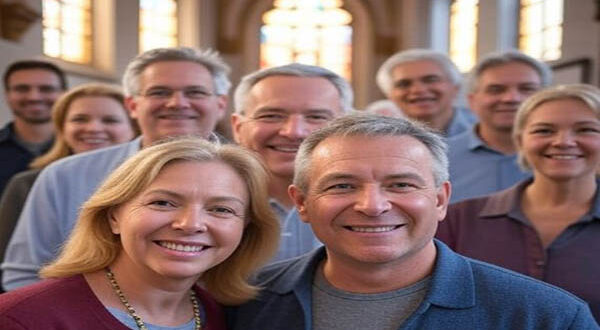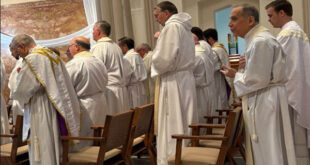Introduction: The Long Road Back
The history of salvation is full of returns. From the prodigal son who comes back into the arms of the father (cf. Lk 15:11–32), to Saint Peter who, after denying Christ, weeps bitterly and becomes a pillar of the Church—returning to God is one of the great movements of the human heart. Returning to the faith, especially after many years away, is not merely a change of habit or just another spiritual choice: it is a resurrection, a work of grace, a love story that reawakens.
Today more than ever, many feel an inner call—subtle or insistent—pushing them to reconnect with the Catholic faith. Some experience it after a crisis, a loss, an illness, or simply an existential void that no worldly solution has been able to fill. Others come back because of the testimony of someone close to them, or due to a growing restlessness that makes them question the meaning of life.
This article is a theological, pastoral, and practical guide for those who wish to return to the Catholic faith after having been away for a long time. You are not alone. The Church, like a loving mother, awaits you with open arms. God has not forgotten you.
I. A Bit of History: Why Have So Many Drifted Away?
Since the mid-20th century, the widespread departure from faith has been increasing, especially in traditionally Catholic countries. Secularization, the crisis of authority, Church scandals, moral relativism, scientism, and a culture of comfort without God have all contributed to the spiritual disaffection of millions.
But there are also more personal reasons: emotional wounds, bad experiences with Church members, misunderstanding of doctrine, or simply a lukewarm attitude that settled in over time.
Drifting away is not always a dramatic rupture; often, it’s a slow slide, almost imperceptible, until one day you realize you no longer pray, no longer receive Communion, no longer go to Confession… and God seems very far away.
However, the Catechism of the Catholic Church reminds us of something essential: “The desire for God is written in the human heart” (CCC 27). And that desire, though buried under layers of indifference or pain, never fully disappears.
II. The Theology of Return: God Never Abandons
Returning to the faith is always God’s initiative. He is the one who seeks, who calls, who comes out to meet us. As the Lord says through the prophet Jeremiah: “I have loved you with an everlasting love; therefore I have continued my faithfulness to you” (Jer 31:3). The one who returns is not saving himself; he is responding to a grace. And that response is the first renewed act of faith.
Saint Augustine, who lived his own conversion process after years of searching and sin, expressed it beautifully: “You have made us for Yourself, O Lord, and our heart is restless until it rests in You.”
Returning to God is rediscovering our true identity. Sin and worldliness distort our original vocation, but grace restores. And the Church is the restoration workshop where Christ, the Good Shepherd, heals wounds and reintegrates the soul into the flock.
III. How to Return to the Catholic Faith After Years Away
1. Acknowledge the Desire to Return
The first step is not to ignore the inner stirring. If something is moving you to come back to God, don’t repress it. That desire, though fragile, can be the doorway to a new life.
2. Pray, Even If You Don’t Know How
Pray. Even if you have no words, even if you feel unworthy. Say simply: “Lord, if You are there, help me come back.” Just speaking to God, even silently, is already prayer. The Holy Spirit intercedes for you, even when you don’t know what to say (cf. Rom 8:26).
3. Seek the Sacrament of Confession
After years away, Confession is the most direct bridge back to grace. Don’t be afraid. Many confessors are especially prepared to welcome those who return after a long time with mercy.
Prepare well: examine your conscience sincerely, without fear or excuses. The Catechism or an examination guide can help you. This is not a court of condemnation, but a tribunal of mercy. Jesus Himself said: “There will be more joy in heaven over one sinner who repents…” (Lk 15:7).
4. Return to the Eucharist
Once you’ve gone to Confession, go to Mass and receive Communion with reverence and gratitude. The Eucharist is the sacrament of unity, the banquet of reunion. Christ becomes your nourishment to strengthen you on this new path.
5. Start Learning Again
Chances are you need to update or rediscover Catholic doctrine. Find a good parish, join study groups, read the Catechism, listen to solid preaching, study the Word. Faith needs to be nourished by truth.
As Saint Peter says: “Always be ready to give an explanation to anyone who asks you for a reason for your hope” (1 Pet 3:15). A mere emotional impulse isn’t enough; you must build on rock.
6. Reclaim Daily Spiritual Practices
Pray each day: a Our Father, a Rosary, a Gospel reading. Visit the Blessed Sacrament, even briefly. Bless your meals. Get used to saying, “Thank you, Lord,” and “Forgive me, Lord.” God dwells in the ordinary.
7. Avoid Perfectionism
Returning to the faith doesn’t mean becoming a saint overnight. There will be setbacks, doubts, fatigue. Don’t despair. God is patient. Daily faithfulness is more valuable than spectacular conversions.
8. Surround Yourself with Fellow Travelers
Faith is not lived in isolation. Find a vibrant community. Look for a good spiritual director or guide. Stay away from toxic environments or influences that pull you from God. Choose your friendships wisely. The communion of saints is an invisible net that sustains you.
IV. Practical Advice for Remaining in the Faith
- Make Sunday Mass a non-negotiable appointment.
- Read one passage of the Gospel each day, even if it’s just one.
- Go to Confession regularly—at least once a month.
- Keep a spiritual journal to note graces received, questions, falls, and resolutions.
- Fast from what pulls you away from God: social media, TV, empty distractions.
- Help others—charity activates faith (cf. Gal 5:6).
- Be patient with yourself—God works at His own pace.
- Create a prayer corner at home: an image, a candle, a Bible.
V. Contemporary Relevance: A Faith for the Modern World
In a world full of noise, anxiety, and superficiality, the Catholic faith offers a deep anchor, a sure compass, a living community, and eternal hope. Returning to the faith is not a backward step, but an advance into the future with solid foundations.
Coming back to the Church is not nostalgia—it is spiritual realism. God is still the only answer to humanity’s greatest questions: Who am I? Why am I here? What does suffering mean? Is there something after death?
VI. A Church That Waits, A Grace That Transforms
The Church is not a club of the perfect, but a hospital for sinners. If you return, don’t expect human perfection, but do expect sacraments that heal, shepherds who guide, doctrine that enlightens, and liturgy that lifts the soul to heaven.
Always remember: faith is not just something you do for God, but something God does in you. It is a gift, a grace, a living relationship.
Conclusion: Your Place Is Waiting
Returning to the Catholic faith is coming home. A table is prepared for you, a seat marked with your name. The Father is waiting. The Church is waiting. Mary covers you with her mantle. Do not be afraid. Take the step.
As Saint Paul says: “Now is the acceptable time, now is the day of salvation” (2 Cor 6:2).
Don’t postpone it any longer. You can return today.






